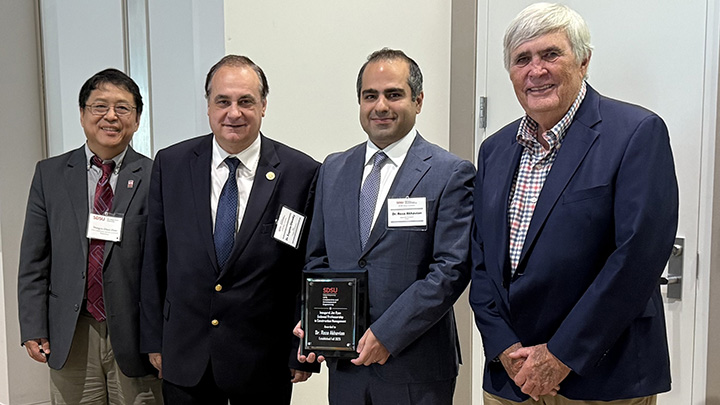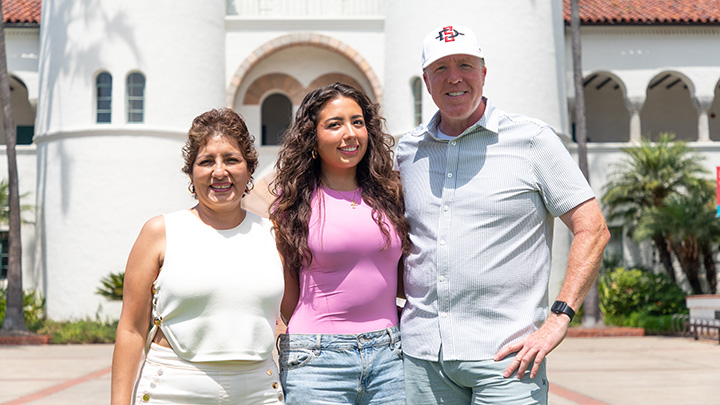The Forbidden Film
SDSU students' parody of a popular 1939 film resurfaces 70-plus years later.

In the fall of 1939, Bob Wade was a 19-year-old San Diego State sophomore looking for a way to raise cash for his fraternity. The Great Depression had dragged on for a decade and money was tight.
Movies were big in 1939, which may have been Hollywood’s banner year for cranking out classics. Among them was Paramount Pictures’ Beau Geste, starring Gary Cooper in the title role. Its plot involves three brothers who join the French Foreign Legion and are sent to North Africa where their adventure leads to danger. Many of the key scenes take place in the fateful Fort Zinderneuf, an isolated desert outpost which provides the film’s most unforgettable images.
Immediately upon its release, Beau Geste was a hit. So Wade and his fraternity brother and good friend, H. Billy Miller, were all ears when an acquaintance came back to school with stories from a job hauling water to the desert set of Fort Zinderneuf, east of El Centro.
“He said, ‘They just went off and left the fort there. They didn’t do anything with it and it’s always deserted,’” Wade remembered. “We thought, ‘Oh, boy, this is it!’
Filming at the fort
They discovered not only was the vacant fort still there, but so were all kinds of abandoned props. Plans were made to assemble a cast of friends and fraternity brothers for a parody version of Beau Geste filmed over Thanksgiving weekend. As Miller and Wade began writing a script, Miller’s grandmother—a talented seamstress—made costumes.
“We went out there on Thanksgiving weekend thinking the three-day holiday would be plenty of time to film the picture and get back home,” Wade said. “How little we knew about moviemaking at that time!
“We actually ended up spending several months out there going back and forth between San Diego and Yuma every spare weekend and financing it with what we all had from part-time jobs,” Wade said.
“Burn the film”
By the spring of 1940 the movie was completed. Wade and Miller made plans to show their film both on and off campus to begin recouping the money they’d spent making it. They figured their Sigma Lambda fraternity would profit, too, but San Diego State’s administration had other ideas.
“Unfortunately, our plans were nipped in the bud when the administration told us we couldn’t use the campus theater because we didn’t own the copyrights to Beau Geste,” Wade said. “Dr. (Walter) Hepner said we’d have to get a waiver from Paramount.”
Undaunted, the teenagers hopped in Wade's old Model A Ford and headed to Hollywood to meet with Paramount executives, who gave them the thumbs-down.
“So we talked to several people and eventually to the legal counsel for Paramount who later became the president of the company and we threw ourselves on his mercy,” Wade recalled. “He said, ‘Well, I can’t give any official approval, but we’ll turn our backs and let you show it three times on campus, and then we’ll have to ask you to burn the film.’
“So that’s why it showed up on campus. It was in the Little Theater. We couldn’t charge on campus so it was a disaster financially. I don’t think the fraternity ever got a dollar out of the whole thing.”
Different and original
But the popularity of the Paramount film and the saga of its student parody combined to create a sensation on the Mesa. Brita Davis (’42), who studied theater and was president of the honorary drama society, Skull and Dagger, remembers the buzz on campus.
“It was exciting,” she recalled. “I would say there was more excitement about that movie than anything that had come along on the campus for a long, long time because we had never had anything like that before.
Davis says she had watched the Hollywood version of Beau Geste several times between 1939 and 1940, so she appreciated Wade and Miller's parody.
“It was funny,” she said. “I’m almost 92, so I don’t remember a lot of it, but there were some things that were very cute and right on the beam of the age of that period.”
A rediscovery
After the Little Theater showings, the student film was never seen in public again until this year when it surfaced at Cinecon, a classic film festival in Hollywood. And just as it had 70 years earlier, Wade and Miller’s film proved a hit with the audience.
The man responsible for the film’s rediscovery is Frank Thompson, a filmmaker, comedy writer and film historian. At an early age, Thompson developed a fascination with the French Foreign Legion and Beau Geste.
Ten years ago Thompson was in San Diego researching a movie and “because I always do it, while I was in the library I just looked up Beau Geste to see if there was anything about it,” he remembered. “I found this one paragraph in a paper that told the basic story about these kids from San Diego State and their spoof about Beau Geste. For years, that was all I knew. I couldn’t find anything else.”
Finding the fort
But in 2008 Thompson would uncover the information he needed. Working on a documentary about the Foreign Legion in popular culture, he set out to locate the site of the desert film set of Fort Zinderneuf. He returned to San Diego to pick up a friend and decided to swing by the university to see if he could find any more information about the 1939 student film project.
“I went to the archives and found some photographs there,” Thompson said. “They had a copy of the poster that said, ‘See it before it’s burned.’ I went looking through old issues of the student paper and found all these articles about it and on the back of the poster there were all these scribbled notes and one of them mentioned Bob Wade.”
A new discovery
Thompson’s discovery fueled an effort to locate anyone having anything to do with the student film. He managed to track down two surviving participants—Bob Wade, who still lives in San Diego, and former San Diego State student Nord Whited who now lives in Placerville.
The filmmaker interviewed both men and was thrilled with the props, photos and movie scripts they gave him. But Thompson was over-the-moon ecstatic with what Wade had to offer.
“When I called him just before I came down,” Thompson recalled, “I said, ‘It’s really a shame about Paramount making you destroy the print,’ and Bob said, ‘Aw, we didn’t destroy it. You want a copy?’ I said, ‘Yes, I do. I’d like a copy of that,’ so he had a video waiting for me when I got there.”
It was that copy Thompson showed at Cinecon. The video provided enough material, combined with Wade and Whited’s interviews, for Thompson to make a separate documentary about the San Diego State students’ parody film.
“It seems to me it’s a story that’s interesting in and of itself,” explains Thompson. “It’s about a specific kind of college fun that maybe doesn’t quite exist anymore. It’s this kind of adventurous camaraderie that they did and it struck me as being a really interesting thing. It just struck me as being so interesting that I couldn’t help but go ahead and tell the story of the student production.”
Incredible rarity
Thompson wants to finish the documentary and find a way to show it, possibly pairing it with the student parody for a double-feature screening on campus. He believes it would find a receptive audience.
“The fact that when I showed the student film at Cinecon and nearly twice as many people showed up as the room was supposed to hold demonstrates there was at least an interest in this,” Thompson reasoned.
“Then there’s the fact of its incredible rarity—this movie has never been shown publicly since March 7, 1940, so nobody has ever seen this thing. And it’s funny. It got big laughs at Cinecon.”
Thompson spoke of his project with a passion approaching the zeal the students must have felt undertaking their first film adventure. “I’ve just been so captivated by this whole story,” he explained.
Continued collaboration
For his part, Wade seems somewhat perplexed that anyone would want to revisit the antics of teenaged college students seven decades after the fact. Both he and Miller, friends since junior high school, had their San Diego State educations interrupted by World War II. They joined the Air Force and never returned to campus as students.
“We did everything together or didn’t do everything together,” Wade joked.
Both got into radio for a time, then continued their creative partnership writing crime novels under the pseudonym of Wade Miller. They penned dozens of books together until Miller’s death in 1961.
Now 90, Wade still writes “Spadework,” a monthly mystery review column for the San Diego Union-Tribune.
“I find it tremendously amusing,” Wade said of the renewed attention the Beau Geste parody is generating. “It’s a little student project that my partner, Bill Miller, and I started out with and that it still has some life and interest in it more than 70-some years later is, to me, incredible.”
This is an abbreviated version of the story originally published in the SDSU Alumni Association Enewsletter. To read the full-length version, click here.


